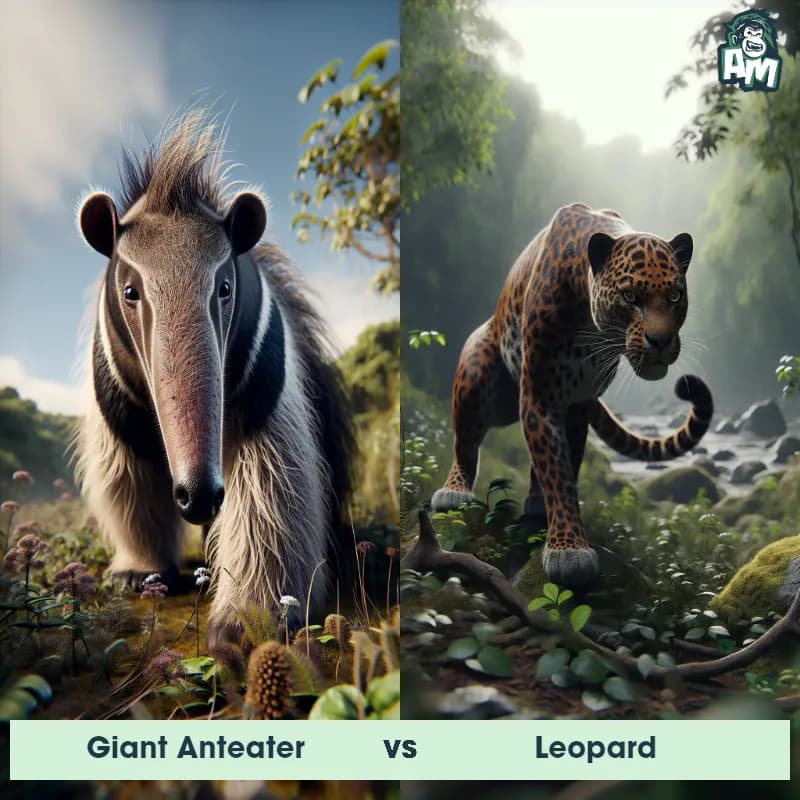Giant Anteater vs LeopardSee Who Wins

Ladies and gentlemen, welcome to a thrilling matchup between a Giant Anteater and a Leopard! These two fierce competitors are ready to go head to head in a battle of strength and skill. Let's see who will come out on top in this three round fight!
Contender 1: Giant Anteater
The Giant Anteater, also known as Myrmecophaga tridactyla, is a unique and fascinating creature found in Central and South America. This extraordinary mammal is known for its distinct appearance, characterized by a long snout, bushy tail, and powerful front claws. The Giant Anteater has a length of up to 7 feet and can weigh between 40 to 140 pounds. Their long snouts are perfectly adapted for their diet of ants and termites, which they locate using their keen sense of smell. With their sharp claws and sticky tongues, they are expert insect hunters. Their fur is coarse and ranges in color from brown to gray, with a distinctive pattern of black and white stripes on their body, aiding in camouflage within their habitat.
Fun Fact: Despite their rather intimidating appearance, Giant Anteaters are peaceful animals, preferring to avoid conflict whenever possible. When threatened, they choose flight over fight and usually rear up on their hind legs, utilizing their powerful claws for defense, displaying an impressive and intimidating display without causing harm.
Contender 2: Leopard
The Leopard is a large and powerful carnivorous mammal that is known for its distinctive coat pattern consisting of rosette-like spots. It has a slender body, muscular limbs, and a long tail, enabling it to be agile and swift. Leopards are primarily nocturnal creatures, preferring to hunt during the cover of darkness. They are highly adaptable and can thrive in a variety of habitats, ranging from dense forests to open grasslands. With exceptional climbing skills, they are capable of dragging their prey up trees to keep it safe from other predators.
Fun Fact: Leopards are incredibly strong and possess immense agility, as they are capable of leaping horizontally up to 6 meters and vertically up to 3 meters, allowing them to ambush their prey from above with precision.
Matchup Stats
| Giant Anteater | Leopard | |
|---|---|---|
| Size | Up to 7 feet (2.1 meters) | 24-28 inches (60-71 cm) at the shoulder; 5-6 feet (1.5-1.8 meters) in length |
| Weight | 40 to 140 pounds (18 to 64 kilograms) | 80-160 pounds (36-73 kilograms) |
| Speed | 30 mph (48 km/h) | 36-37mph (58-60km/h) |
| Key Strength | Sharp, powerful front claws | Powerful jaw and sharp claws |
| Biggest Weakness | Prefers flight over fight | Less endurance compared to some other big cats |
Current Votes
Giant Anteater vs Leopard
See Who Wins
View More Matches
Looking For More?
Similar Matches
Scientific Stats
| Giant Anteater | Leopard | |
|---|---|---|
| Scientific Name | Myrmecophaga tridactyla | Panthera pardus |
| Family | Myrmecophagidae | Felidae |
| Habitat | Grasslands, rainforests, savannas | Variety of habitats including forests, grasslands, and mountains |
| Geography | Central and South America | Africa, parts of Asia |
| Diet | Ants and termites | Carnivorous, preys on various animals including ungulates, small mammals, birds, and reptiles |
| Lifespan | 10 years - 15 years | 12 years - 17 years |
Key Differences between Giant Anteater and Leopard
- Size: The Giant Anteater is significantly larger than the Leopard, with adults reaching lengths of up to 7 feet and weighing between 60 to 90 pounds, whereas Leopards are much smaller, typically measuring around 4 to 6 feet in length and weighing between 66 to 176 pounds.
- Color: The Giant Anteater has a distinctive black and white coat with a diagonal stripe pattern on its body, while Leopards have a yellow or gold coat covered with dark rosettes and spots.
- Body shape: The Giant Anteater has a long, tubular body with a large bushy tail, thin legs, and a long snout adapted for feeding on ants and termites, while Leopards have a more compact, muscular body with shorter legs and a shorter snout for hunting prey.
- Habitat: Giant Anteaters are primarily found in grasslands, savannas, and tropical forests of Central and South America, while Leopards inhabit a wide range of habitats including forests, grasslands, deserts, and mountains in Africa and Asia.
- Conservation status: The Giant Anteater is listed as vulnerable by the IUCN due to habitat loss and hunting, while Leopards are listed as vulnerable or endangered in some regions due to poaching and habitat destruction.
- Behavior: Giant Anteaters are solitary animals that are mainly active during the day, while Leopards are solitary and secretive predators that are most active during the night.
































